A Lavender Topiary has natural beauty as well as an enticing scent. One may easily be added to your house or garden to give a natural touch and a splash of color!
Topiaries of various types have long inspired me. There’s just something about the slightly formal, elegant appearance and shape of them that I like!
They’re so easy to care for, and I think little Lavender should be in every garden.
Native to the rugged climatic condition of Europe, the Lavender Topiary is reasonably hardy, and you can grow it both indoors and outdoors.
If you acquaint yourself with the basics of caring for a Lavender Topiary, you will be rewarded with a beautiful plant that gives off a soothing, relaxing fragrance.
Continue reading to find out how to cultivate and care for a Lavender Topiary indoors and out.
Table of Contents Show
Difference Between a Typical Lavender Plant and a Lavender Topiary
Lavender Topiary is made from Lavender plants that are properly trimmed, cut, and trained to grow from the top.
Like a standard tree, it has a bare wooden stem with branches, leaves, and flowers growing from the top.
Depending on your taste, you can trim it to be rounded or spikey, or give it any other look you like.
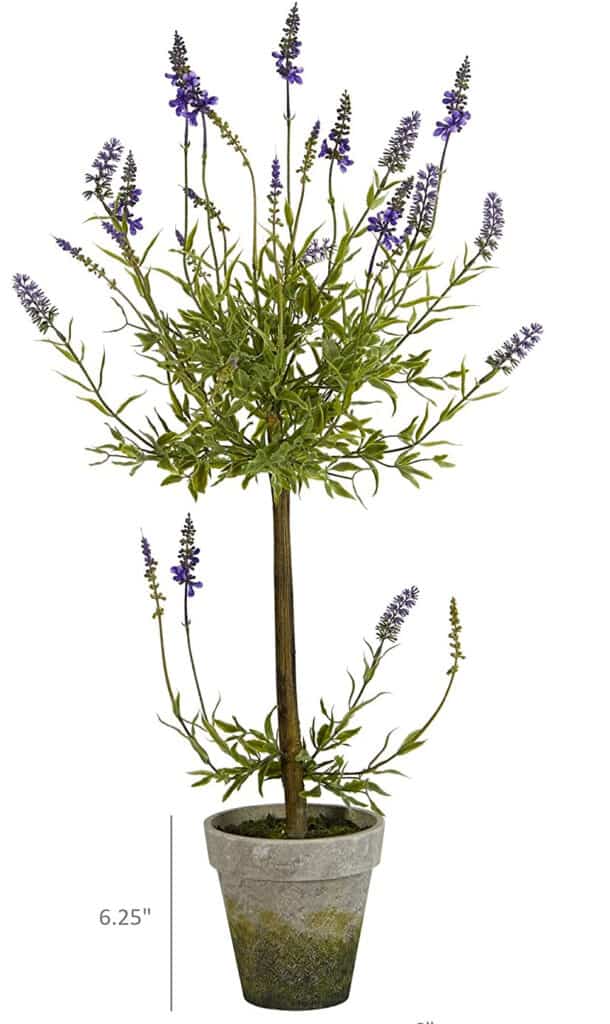
Caring for your Lavender Topiary
Growing a Lavender Topiary is similar to growing other plants.
It can tolerate most growing conditions but will do best when provided with well-draining soil and adequate sun.
This plant is pretty low-maintenance and easy to care for. So, it will serve as a decoration for many years if cared for properly.
Let us go through a few factors that dictate how your plant turns out to be.
1. Light Requirement
Providing your Lavender plant with adequate light is one of the essential aspects.
Your Lavender will thrive if you keep it at a windowsill or a South-facing window where it gets a minimum of 5-6 hours of full sunlight daily.
If you don’t have a South-facing window, try locating your plant in a West window.
If you want to plant your Lavender Topiary outdoors, keep it where it receives at least 6 hours of full sunlight.

Wherever you put your plant, remember to rotate the pot weekly to promote even growth and flowering.
Try not to put your plant at a place where it will be overshadowed by shade or any other plant.
Without enough sunlight, your plant will start to show weak growth and cease to produce any flowers. Unfortunately, this also makes it more vulnerable to diseases.
2. Watering Requirement
Due to its hardiness, it is incredibly resistant to drought stress once appropriately established.
Drench the soil thoroughly when watering and allow it to dry out slightly between waterings.
As Lavender is a native plant to the Mediterranean, it prefers to stay moist but not wet.
This plant is highly susceptible to diseases like root rot. So, overwatering can quickly jeopardize your whole plant.
To know when to water your plant, check the top 1-inch of the soil with your finger. If it is wet, then there is no need for watering.
Water once or twice a week when the plant is newly established. After it matures, you need to water it at least two to three times a week until the buds form.
Cut back to once or twice weekly until the time of harvest.
In winter, lessen the frequency of watering. Only water if the top 2-inch of the soil is dry.
3. Temperature and Humidity
Proper temperature encourages healthy growth and frequent flowering.
The ideal room temperature for your Lavender Topiary is 70°F (21°C) during the day and 50-55°F (10-13°C) at night-time during its growing season.
In the winter season, it enjoys a temperature of 60-65°F (15-18°C) during the day and 45-50°F (7-10°C) at night.
Keep your plant in a place where it receives ample direct sunlight daily. It will help to maintain sufficient temperature for your plant.
Unlike most other tropical houseplants, Lavender Topiary instead prefers a low-humid environment.
Lavenders can’t tolerate high humidity in both the soil and the air. However, most households have an average humidity of 30-40%, suitable for growing Lavenders.
Lavender Topiary doesn’t need any additional sources of humidity like pebble tray or humidifier to thrive.
Being a hardy perennial herb, it can do well on its own, and you might only damage it if you make the environment more humid.
Provide good ventilation and air circulation but avoid putting it in direct line of heaters or air-conditioners.
4. Fertilizing your Lavender Topiary
Generally speaking, Lavender Topiary requires a bit less fertilizing than most other plants.
Over-fertilizing is an issue for most amateur growers that can lead to excess foliage, yellowing, and no bloom.
Most gardening experts recommend fertilizing your plant once, generally before the start of the growing season (before springtime and summer).
Most gardening experts recommend putting an inch of compost around the plant as an organic fertilizer which can provide enough nutrients for your plant year long.
If you prefer to buy your fertilizers, then liquid fertilizers like Lavender & Rosemary Fertilizer or any organic Phosphorous-rich NPK fertilizer like Neudorff Azet Lavender Fertilizer is ideal.

Follow the instruction manual on the back for proper growth and to avoid over-fertilizing.
5. Pot Size and Material
Lavender Topiary grows excellent in pots and containers. However, you need to consider a few things before you choose the best pot for your plant.
Some Lavender species can have a modest height of 16-18 inches, whereas others can reach 30-36 inches.
For all the Lavender species, it is recommended that you grow your plant in pots about 12-16 inches in diameter and have proportional depth.
Similarly, a Ceramic or Terra Cotta-style pot is the ideal choice that won’t allow the soil to dry off as much.
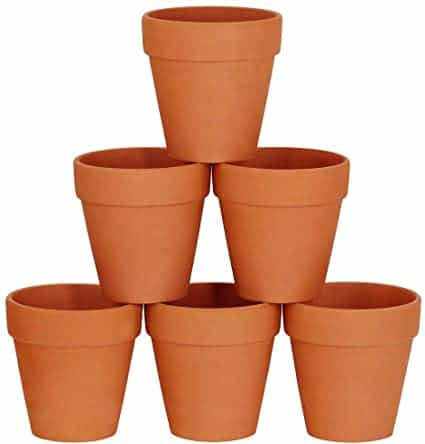
6. Potting Mix
Lavender grows best in a loose, friable mixture with good water draining and aeration capacity.
Although most plants prefer compost-rich, humus, and soil with organic materials, Lavender likes sandy, gravelly, rocky, and almost poor soil types.
It prefers slightly alkaline soil with a pH range of 7.0-8.0.
You can make your Potting soil by mixing:
- One part compost
- 1 part perlite
- One part coarse sand
- 1 part fine soil
Tips: You can add a few bits of eggshells or lime depending on the amount of soil to adjust the pH to become alkaline.
If you prefer to go the commercial route, you can buy potting soil mixed specially for Lavender on Amazon.
7. Repotting Lavender Topiary
Lavender Topiary does not need constant repotting if you have already used a big enough pot size to plant it.
If you Lavender starts to outgrow the pot, you can repot it in a new one.
However, some people suggest repotting Lavender once an entirely unnecessary year. It can also cause stress to your plant and do more harm than good.
In general, the Lavendar topiary can be repotted once every two years to prevent it from becoming root-bound.
Repotting any plant is done mainly for two reasons: when the plant starts to outgrow and when the soil lacks nutrients.
If you have already used an ideal pot size, repotting is redundant.
As the Lavender plant does not need nutrient-rich soil, it is also of no good to keep repotting your plant in new soil every year.
Follow the below instructions to repot your Lavender Topiary:
- Select a pot size that is at least 12-16 inches in diameter.
- Add small stones or pebbles to the bottom of the plant for better drainage.
- Select a good potting mix and fill the pot with a couple of inches of soil.
- Take off your Lavender Topiary carefully from the other pot and place it in the new one.
- Fill the pot with a couple of inches of soil and firmly press it to remove air pockets.
- Thoroughly water your plant.
- Place it where it gets at least 6-8 hours of sunlight.
8. Troubleshooting Lavender Topiary
If not provided a suitable environment, then your Lavender Topiary can face a myriad of problems.
It can result in wilting, yellowing of leaves, root rot, and in some severe cases, death of the plant.
Some of the significant factors that contribute to these problems in your Lavender Topiary are:
- Overwatering your plant
- High levels of humidity
- Lack of enough light
- Wrong Soil pH
- Too much pruning leading to woody growth
- Root rot due to the bad soil mix
- Pests like spittlebugs or froghoppers.
- Lavender Shab disease
- The wrong type of Lavender for your climate
If you follow the care routine mentioned in this article, you won’t have to worry about your Lavender Topiary facing these problems.
Take Care of Lavender Topiary Indoors vs. Outdoors in Winter
Lavenders grow best outdoors, but they will grow indoors just as well if you provide the primary care requirements listed above.
The care requirements for Lavender Topiary indoors and outdoors during the growing season is pretty much the same. However, a few things need to be considered over the winter, depending on where you choose to plant.
During the winter season, your Lavender Topiary generally becomes dormant.
You can follow these instructions below to care for your Lavender Topiary in winter properly.
Care for Lavender Topiary Outdoors in the Ground during Winter
If you’ve planted your Lavender Topiary in the ground, then two important things need to be considered.
- Prune your Lavender into a dense mound shape to reduce the effect of the harsh winter. (For more information on how to prune, check the pruning section below).
- Remove all the fallen leaves as they can add excess moisture to the soil.
- Water only if the top 2-inch of the soil is dry.
You can also add some gravel or sand around your plant as a mulch, which will help suppress weeds’ growth.
Sand will be perfect as it will slowly seep into the soil creating a well-draining porous structure.
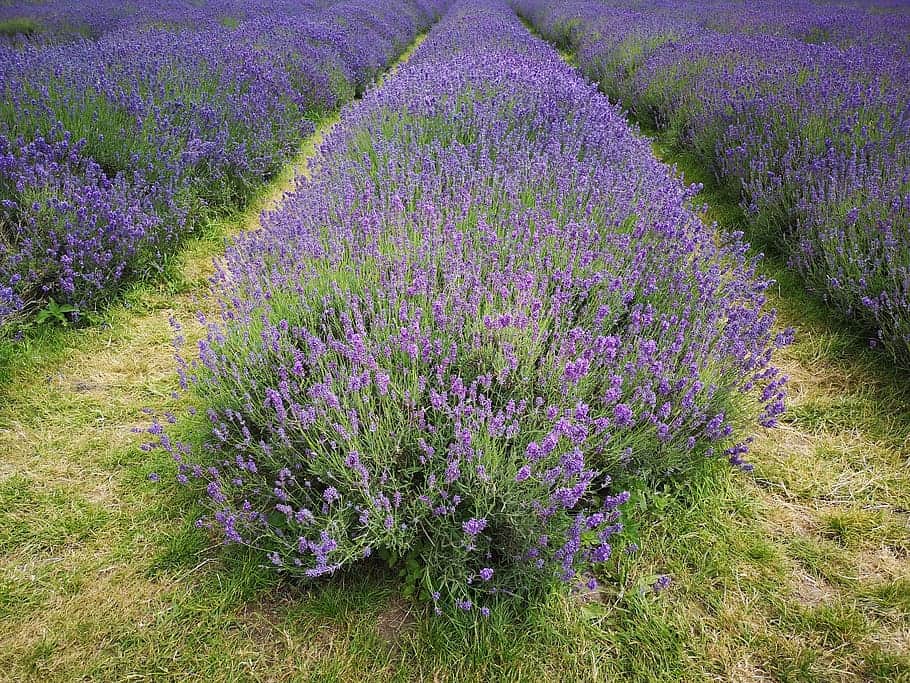
Care for Lavender Topiary Outdoors in a Pot during Winter
The best thing you can do in winter is the bring your Lavender Topiary inside.
But it is not as easy as it sounds since there are a few things to consider to acclimatize your plant to a new location.
- Before moving your plant indoors, place it outdoors where it receives less sunlight than it used to. Do it each day of the week and increase time towards the end. Then, leave it in the same spot without moving for a week.
- Move your plant indoors for a couple of hours daily for a week, gradually increasing the time inside.
- After about a week, you can move the plant indoors.
- Place it in a location where it receives good sunlight and proper aeration.
- Try not to water as much during the summer.
- During winter, it’s best if you don’t fertilize your plant.
If bringing your Lavender Topiary indoors is not possible, then follow the below instructions.
- Dig a hole deep enough to place the pot in the ground.
- Place your pot in such a way that the soil level of the pot and the ground are the same.
- Give it protection by covering the pot’s area with a sheet of steel plate, wooden planks, or anything that can insulate the roots.
If burying your pot is also not possible, you can either move your pot near a wall or shed to provide it from the wind.
Alternatively, you can put your potted plant inside a larger pot and fill the space with mulch or soil for insulation against the cold.
Care for Lavender Topiary Indoors in Winter
As this plant is pretty hardy, caring for Lavenders indoors over winter is pretty straightforward.
It would help if you kept a few things in mind to care for your Lavender Topiary indoors.
- Avoid placing it in high-humidity rooms that can result in root rot.
- Even though it won’t grow actively, it still needs enough light.
- Keep it away from a drafty place or a line of heaters.
- Provide ample space for proper air circulation.
- It does not require much water; providing water once every 4-6 weeks will be enough.
- It is not necessary to fertilize your plants during the winter.
- Add mulch to the base of your plant to prevent frost.
Pruning your Lavender Topiary
Lavender Topiary needs pruning annually, which helps to keep it from growing out of control and maintaining its shape.
Pruning will encourage new growth and flowering, all the while keeping your plant healthy.
Without it, the Lavender Topiary will grow a large woody base that can shorten the lifespan of your plant.
When to Prune your Lavender Topiary?
Prune your Lavender twice in the growing season. Once, after the first flowering in the early spring and once in the fall before winter approaches.
Ideally, the best time to prune your Lavender Topiary in early spring is after its first growth. The last pruning should be done in early fall before the winter damages new development.
How to Prune your Lavender Topiary?
Pruning Lavender Topiary is pretty straightforward and does not require much effort.
Follow the steps below to keep your Lavender Topiary look stunning and healthy for years to come.
- Get sharp scissors or a pair of pruning shears.
- Wipe your equipment on both sides to rubbing alcohol to kill any harmful bacteria.
- Wear gloves to prevent contamination.
- Locate the woody base of the stem cut 2-3 inches above it. Also, be careful not to damage new growth.
- You can shape your topiary to a mounded bun to give it a more symmetrical look.
Avoid these things when pruning your Lavender Topiary.
- Don’t cut the woody stem of the plant.
- Don’t cut too much foliage. Always leave some greens on the stem.
- Avoid pruning your Lavender after late August as the new growth won’t survive the harsh winter.
Check out this short video on how to prune your Lavender Topiary correctly.
Deadheading Lavender Topiary
Deadheading refers to the process of removing the dead flowers from your plant.
Along with being aesthetically pleasing, deadheading also encourages new growth and helps to control the spread of seeds.
Not only that, but it also increases the lifespan of your plant.
The best time to deadhead your Lavender plant is after every blooming.
How to Deadhead your Lavender Topiary?
Deadheading is a simple activity that does not require extensive knowledge and tools.
You can use a pair of clean sterilized scissors or your index finger and thumb to deadhead your Lavender Topiary.
You can follow these steps to deadhead your Lavender Topiary.
- First, gather your equipment and make sure that they are clean and sterilized.
- Locate spent flowers and dead leaves.
- Make a quick cut on the base of the spent flowers and the leaves.
- If you don’t have any equipment, then pinch off the unnecessary parts.
- Check carefully to ensure that no dead plant parts remain.
- Clean the spent parts from the surroundings as it can act as mulch for the soil we don’t want.
Care for Different Types of Lavender Topiary
Lavender is part of the mint family that consists of over 200 genera and more than 6,000 species. It is part of the same family as Rosemary, Thyme, and Basil.
All in all, there are over 450 varieties of Lavender categorized into 47 species. But the main types are English, French, Spanish, Portuguese, and lavandin.
Although most primary care requirements are the same, there are still some minor differences.
It’s also important to know which type of Lavender to choose based on your region’s climate and care for it accordingly.
1. English Lavender (Lanvandula angustifolia)
This Lavender is also known as true Lavender or common Lavender. When people say Lavender, most of them refer to this variety.
This type of Lavender blooms from early summer to mid-summer. Therefore, you need to prune it accordingly.
It is hardy from zones 5-9 and mainly cultivated outdoors. It can tolerate a high level of cold than other varieties.

2. French Lavender (Lavandula dentata)
Native to Eastern and Southern Spain, its name ‘dentata’ comes from its tooth-like leaves.
This plant grows from early summer to fall. Time your pruning likewise.
It is hardy from zones 8-9. This means that this plant is more susceptible to damage in winter than English Lavender.
Planting this type indoors is favored as it can tolerate fluctuating temperatures indoors better than other species.
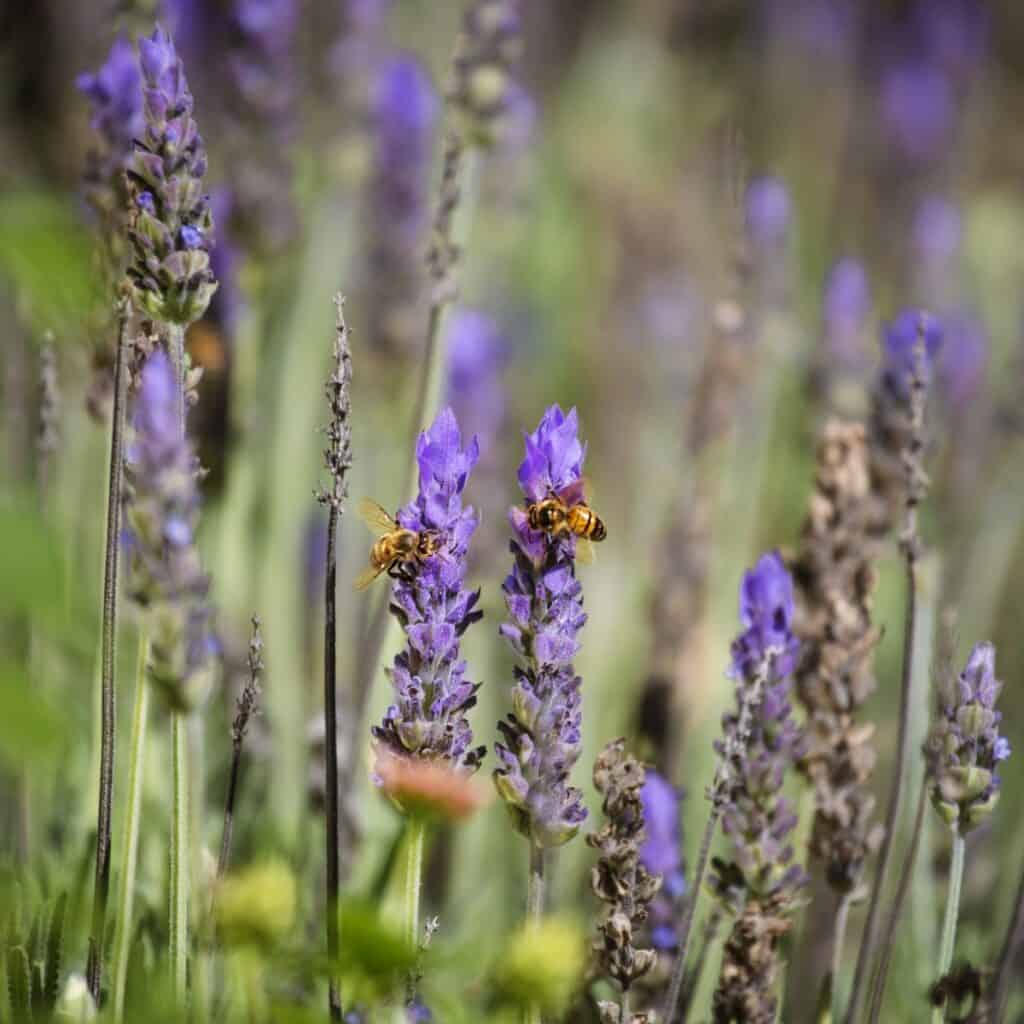
3. Spanish Lavender (Lavandula stoechas)
Sometimes referred to as the French Lavender, it is also called Butterfly Lavender for its tendency to produce distinct bracts with rabbit-like ears.
Spanish Lavender grows continuously from mid-spring to late summer and forms an 18-24 inches bushy mound.
It can tolerate high levels of humidity from the other types. Thus, it is hardy from zones 8-9.
Due to its bushy appearance, it’s grown in mass as ground covers rather than in pots.

4. Portuguese Lavender (Lavandula latifolia)
Native to the Western Mediterranean region, it is famous for its intensely aromatic flowers.
This plant is hardy in zones 6-8 and grows up to 1-3 feet tall. Thus, it is best grown outdoors.
Depending on the weather, it blooms mainly from late spring to late summer.

5. Lavandin (Lavandula x intermedia)
This plant is a hybrid cross between English Lavender and Portuguese Lavender.
It typically blooms later than other varieties, generally in July or August, lasting until late summer.
Since it is hardy from zones 5-9, it is an excellent choice for mass gardening, herb gardens, borders, or accent plants.
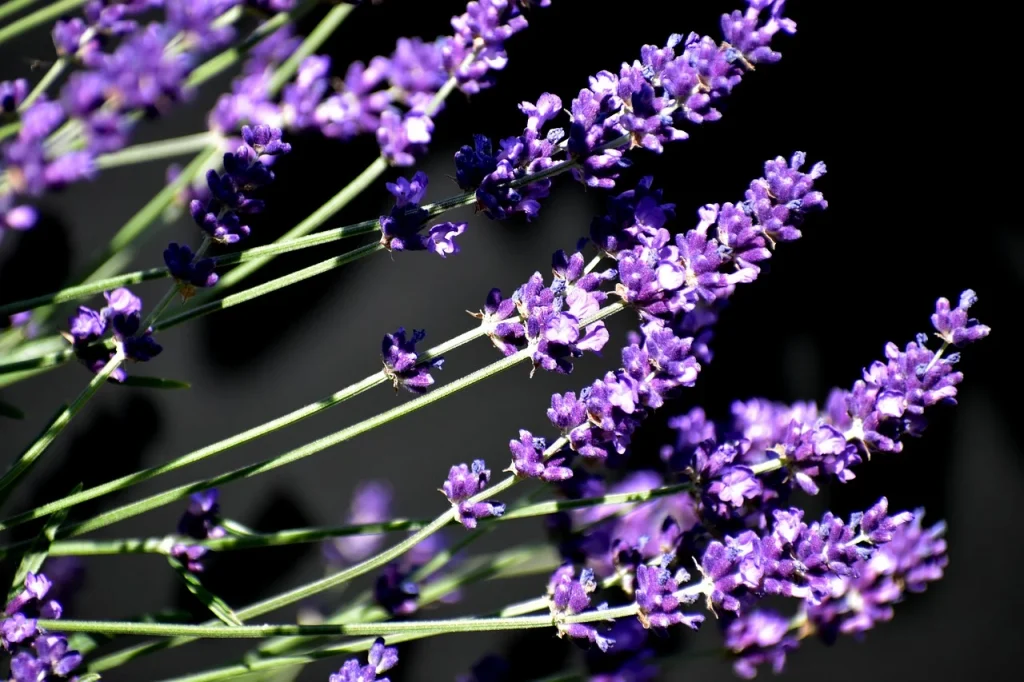
Wrapping Up
Lavender Topiary has several uses, from aromatherapy, essential oils, and perfumes to medicines.
Along with its various uses, it has many varieties and species suitable to different climates.
So, if you’ve been yearning to grow this fragrant, beautiful plant, now is better to start.
With this vast treasure of knowledge, you can grow a healthy, beautiful plant.


